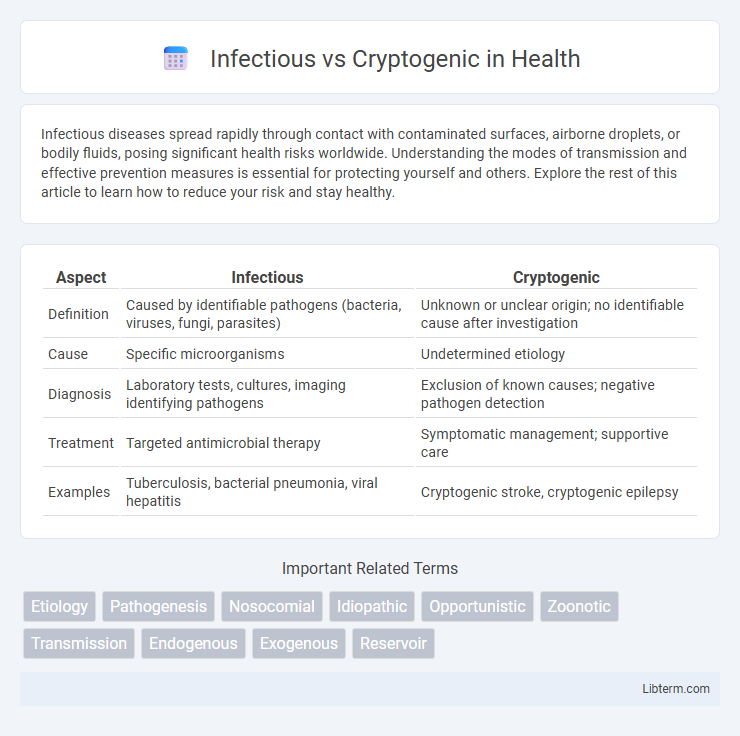Infectious diseases spread rapidly through contact with contaminated surfaces, airborne droplets, or bodily fluids, posing significant health risks worldwide. Understanding the modes of transmission and effective prevention measures is essential for protecting yourself and others. Explore the rest of this article to learn how to reduce your risk and stay healthy.
Table of Comparison
| Aspect | Infectious | Cryptogenic |
|---|---|---|
| Definition | Caused by identifiable pathogens (bacteria, viruses, fungi, parasites) | Unknown or unclear origin; no identifiable cause after investigation |
| Cause | Specific microorganisms | Undetermined etiology |
| Diagnosis | Laboratory tests, cultures, imaging identifying pathogens | Exclusion of known causes; negative pathogen detection |
| Treatment | Targeted antimicrobial therapy | Symptomatic management; supportive care |
| Examples | Tuberculosis, bacterial pneumonia, viral hepatitis | Cryptogenic stroke, cryptogenic epilepsy |
Understanding Infectious vs. Cryptogenic Diseases
Infectious diseases are caused by pathogens such as bacteria, viruses, fungi, or parasites that can be transmitted between individuals, while cryptogenic diseases have unknown or obscure origins despite extensive medical evaluation. Understanding the distinction is crucial for diagnosis and treatment, as infectious diseases often respond to antimicrobial therapies, whereas cryptogenic conditions require targeted research to uncover underlying mechanisms. Precise identification impacts patient management and helps guide epidemiological control strategies in healthcare settings.
Defining Infectious Diseases: Causes and Transmission
Infectious diseases are caused by pathogenic microorganisms such as bacteria, viruses, fungi, or parasites, which can be transmitted directly through physical contact, respiratory droplets, bodily fluids, or indirectly via contaminated surfaces and vectors like mosquitoes. These diseases trigger host immune responses and can spread rapidly within populations, posing significant public health challenges. Understanding transmission pathways is crucial for controlling outbreaks and implementing effective infection prevention strategies.
What Does "Cryptogenic" Mean in Medicine?
Cryptogenic in medicine refers to diseases or conditions with an unknown or unclear cause despite thorough investigation, often used to describe certain types of strokes, seizures, or infections when no specific source is identified. Infectious diseases result from pathogens like bacteria, viruses, or fungi, whereas cryptogenic conditions lack a detectable infectious agent or obvious origin. Understanding cryptogenic etiology challenges diagnostic processes and often necessitates advanced imaging, laboratory tests, and ongoing monitoring to guide effective treatment.
Key Differences: Infectious vs. Cryptogenic Etiology
Infectious etiology involves the presence of identifiable pathogens such as bacteria, viruses, or fungi causing disease, whereas cryptogenic etiology refers to cases where the underlying cause remains unknown despite thorough investigation. Infectious conditions often present with symptoms linked to the specific pathogen and may respond to targeted antimicrobial therapies, while cryptogenic cases lack clear biomarkers or identifiable infectious agents. Diagnostic differentiation relies on microbial cultures, serological tests, and molecular assays for infectious causes, contrasted with extensive exclusion of known sources in cryptogenic diagnoses.
Common Examples of Infectious Diseases
Common examples of infectious diseases include influenza, tuberculosis, HIV/AIDS, and malaria, all caused by pathogens such as viruses, bacteria, and parasites. These diseases are transmitted through direct contact, airborne particles, or vectors like mosquitoes. Differentiating infectious diseases from cryptogenic conditions, which have unknown origins, is crucial for targeted treatment and public health management.
Common Examples of Cryptogenic Diseases
Cryptogenic diseases are medical conditions with unknown or obscure causes, often identified after excluding infectious, genetic, or environmental factors. Common examples include cryptogenic stroke, cryptogenic liver cirrhosis, and cryptogenic organizing pneumonia, where diagnostic challenges complicate treatment strategies. Understanding the distinction between infectious diseases caused by pathogens and cryptogenic diseases with unclear origins is crucial for accurate diagnosis and targeted therapeutic interventions.
Diagnostic Challenges in Cryptogenic Conditions
Cryptogenic conditions present significant diagnostic challenges due to the absence of identifiable infectious agents or clear etiological factors, complicating accurate diagnosis and targeted treatment. Advanced imaging techniques, comprehensive laboratory testing, and molecular diagnostics are critical in differentiating cryptogenic cases from infectious causes by excluding known pathogens and underlying diseases. Misdiagnosis risks prolonged illness and inappropriate therapy, underscoring the need for improved biomarkers and standardized diagnostic protocols in cryptogenic disease management.
Treatment Approaches: Infectious vs. Cryptogenic
Treatment approaches for infectious conditions primarily involve targeted antimicrobial therapies such as antibiotics, antivirals, or antifungals based on the identified pathogen. Cryptogenic conditions, lacking a clear infectious cause, often require symptom management and supportive care, including anti-inflammatory or immunosuppressive agents when an autoimmune component is suspected. Accurate diagnosis through advanced imaging, lab tests, and biopsies guides the choice between pathogen-specific medications and broader immunomodulatory treatments.
Prognosis and Outcomes in Each Category
Infectious etiologies often present with a more predictable prognosis due to targeted antimicrobial therapies, resulting in generally favorable outcomes if diagnosed early. Cryptogenic cases pose challenges in prognosis due to unknown origins, often leading to variable outcomes and necessitating extensive monitoring and personalized management. The distinction between infectious and cryptogenic causes significantly influences treatment strategies and long-term disease prognosis.
Importance of Accurate Classification in Patient Care
Accurate classification of infectious versus cryptogenic origins in diseases is crucial for effective patient care, guiding targeted treatment strategies and improving prognosis. Infectious etiologies require antimicrobial therapy and infection control measures, whereas cryptogenic conditions often demand extensive diagnostic evaluation and tailored management. Precise differentiation reduces unnecessary treatments, limits resistance development, and enhances patient outcomes through personalized medical interventions.
Infectious Infographic

 libterm.com
libterm.com